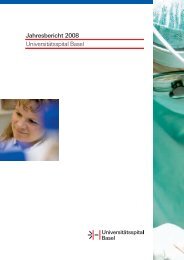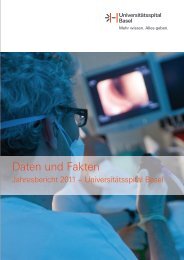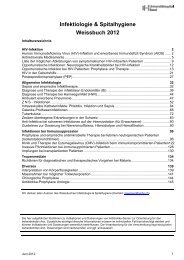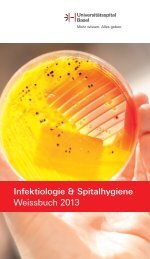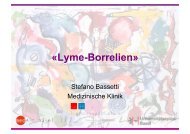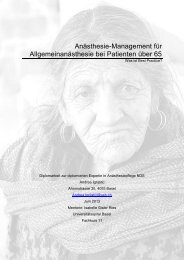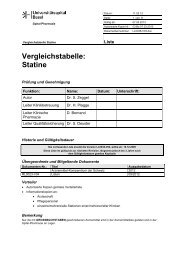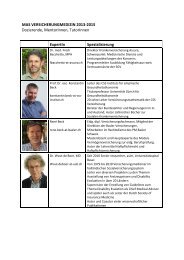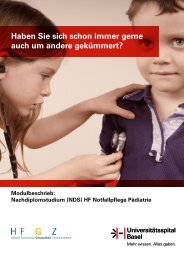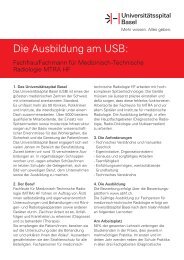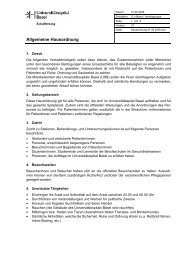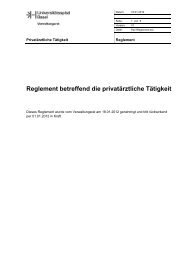Transmucosal Nasal Drug Delivery: Systemic Bioavailability of ...
Transmucosal Nasal Drug Delivery: Systemic Bioavailability of ...
Transmucosal Nasal Drug Delivery: Systemic Bioavailability of ...
Create successful ePaper yourself
Turn your PDF publications into a flip-book with our unique Google optimized e-Paper software.
2. Impact <strong>of</strong> anatomy and physiology on transmucosal nasal drug delivery<br />
nasopharynx, the transported mucus layer with the trapped inhaled particles is swallowed or<br />
expectorated. Cilia in isolation are sensitive to temperature, optimally working at 35-40°C, and<br />
below these temperatures, the natural beat frequency drops [Jones 2001]. Increased mucus<br />
production in the respiratory tract is a symptom <strong>of</strong> many common diseases, such as the common<br />
cold.<br />
<strong>Nasal</strong> mucociliary clearance describes the removal <strong>of</strong> inhaled particles, viruses and bacteria by the<br />
combined function <strong>of</strong> cilia and mucus layers. <strong>Nasal</strong> mucociliary clearance is important for the<br />
protection <strong>of</strong> the respiratory system [Merkus, et al. 1998]. It takes approximately 20-30 minutes to<br />
remove the whole mucus layer [Bommer 2002]. Mucociliary clearance is independent <strong>of</strong> age and<br />
sex [Kao et al., 1994].<br />
Extend <strong>of</strong> transmucosal nasal drug absorption is related to contact time <strong>of</strong> the delivered drug with<br />
the nasal mucosa. <strong>Nasal</strong> mucociliary clearance limits the residence time <strong>of</strong> drugs administered into<br />
the nasal cavities, decreasing the time available for the drug to be absorbed [Merkus, et al. 1998].<br />
In the nasopharynx, not absorbed compounds are swallowed, followed by gastrointestinal<br />
degradation, gastrointestinal absorption, and/or hepatic metabolization.<br />
Mucociliary clearance can be modified by nasally administered drugs or components <strong>of</strong> the vehicle<br />
(viscosity enhancers, mucoadhesive excipients).<br />
Evaluation <strong>of</strong> the effects <strong>of</strong> drugs and additives on nasal mucociliary clearance is an important<br />
issue, especially in developing preparations for long-term treatments. The measurement <strong>of</strong> ciliary<br />
beat frequency in vitro is a very accurate and reproducible technique to determine the effects on<br />
ciliated epithelium. Therefore, assessment <strong>of</strong> ciliary beat frequency is a screening method to<br />
estimate potential toxicity <strong>of</strong> drugs and excipients and to compare nasal preparations. However,<br />
ciliary beat frequency data have to be interpreted carefully, because effects <strong>of</strong> nasal formulations in<br />
vitro are usually stronger than effects in vivo [Merkus, et al. 1998]. In vivo, the mucus layer protects<br />
cilia and dilutes the nasally delivered preparations, whereas in vitro, the cilia are in direct contact<br />
with the formulations. Furthermore, the nasal mucosa continuously regenerates.<br />
Consequently, it is difficult to predict the effects <strong>of</strong> chronic application on mucociliary clearance in<br />
vivo based on ciliary beat frequency assessment in vitro.<br />
For the term ‘ciliotoxic’ no defined criteria exist and the classification depends on the performed in<br />
vitro assays. Furthermore, the cilioinhibitory effects <strong>of</strong> compound or vehicle depend on the applied<br />
concentration and are <strong>of</strong>ten additive [Merkus, et al. 1998]. To predict the safety <strong>of</strong> nasal drug<br />
formulations for human use, it is important to investigate the effects <strong>of</strong> therapeutic concentrations,<br />
both in vitro and in vivo.<br />
Katja Suter-Zimmermann Page 20 <strong>of</strong> 188 University <strong>of</strong> Basel, 2008




